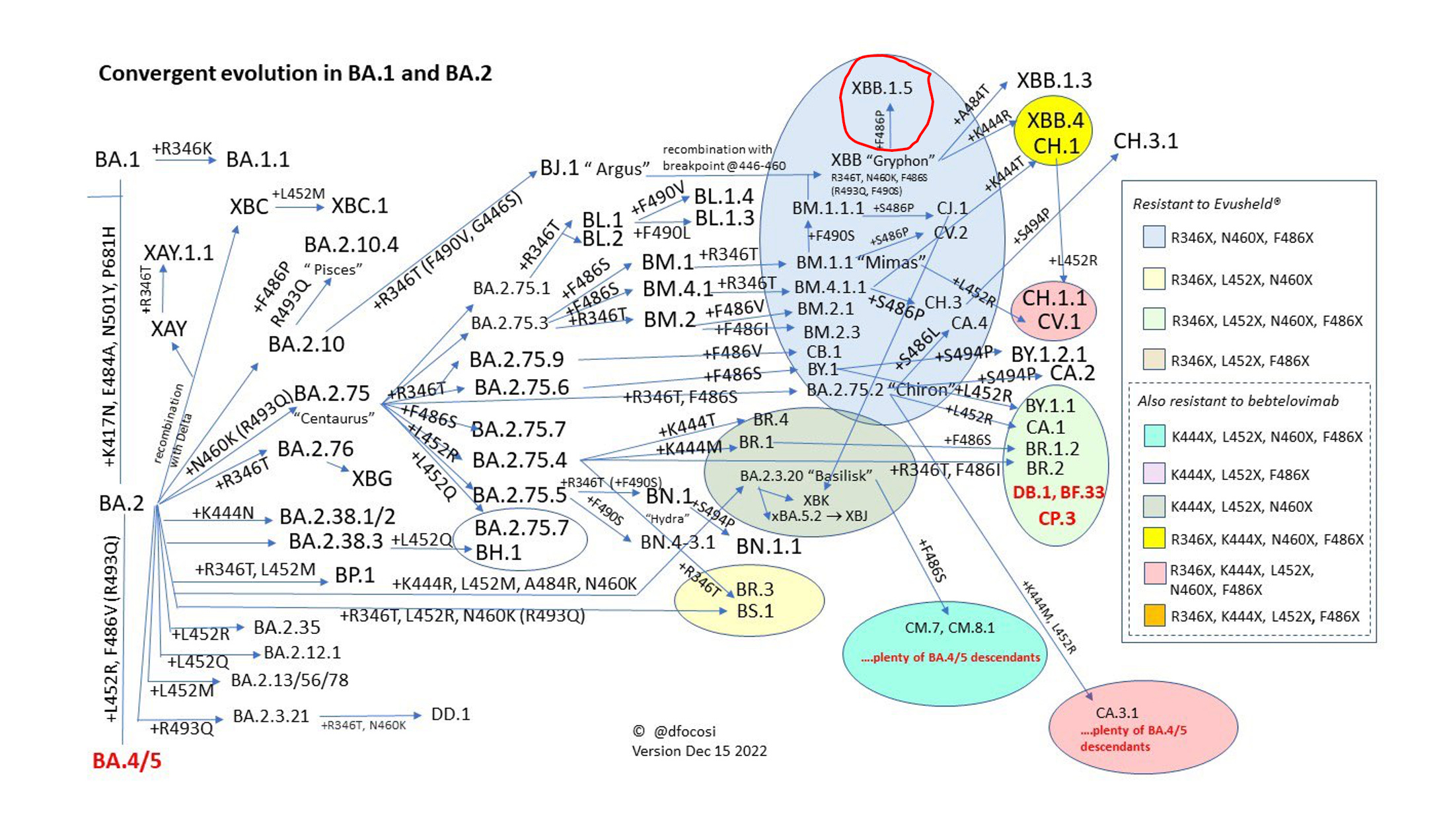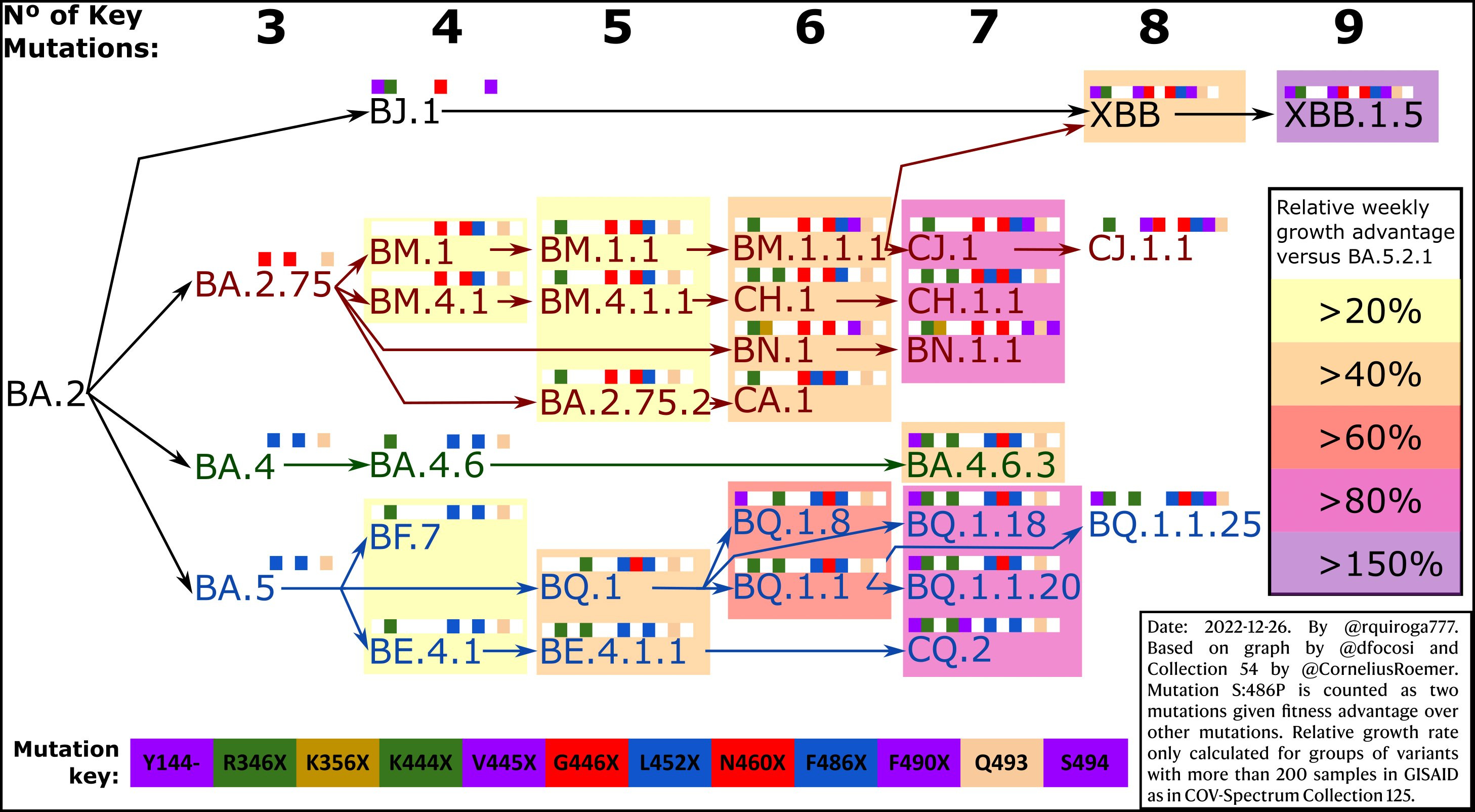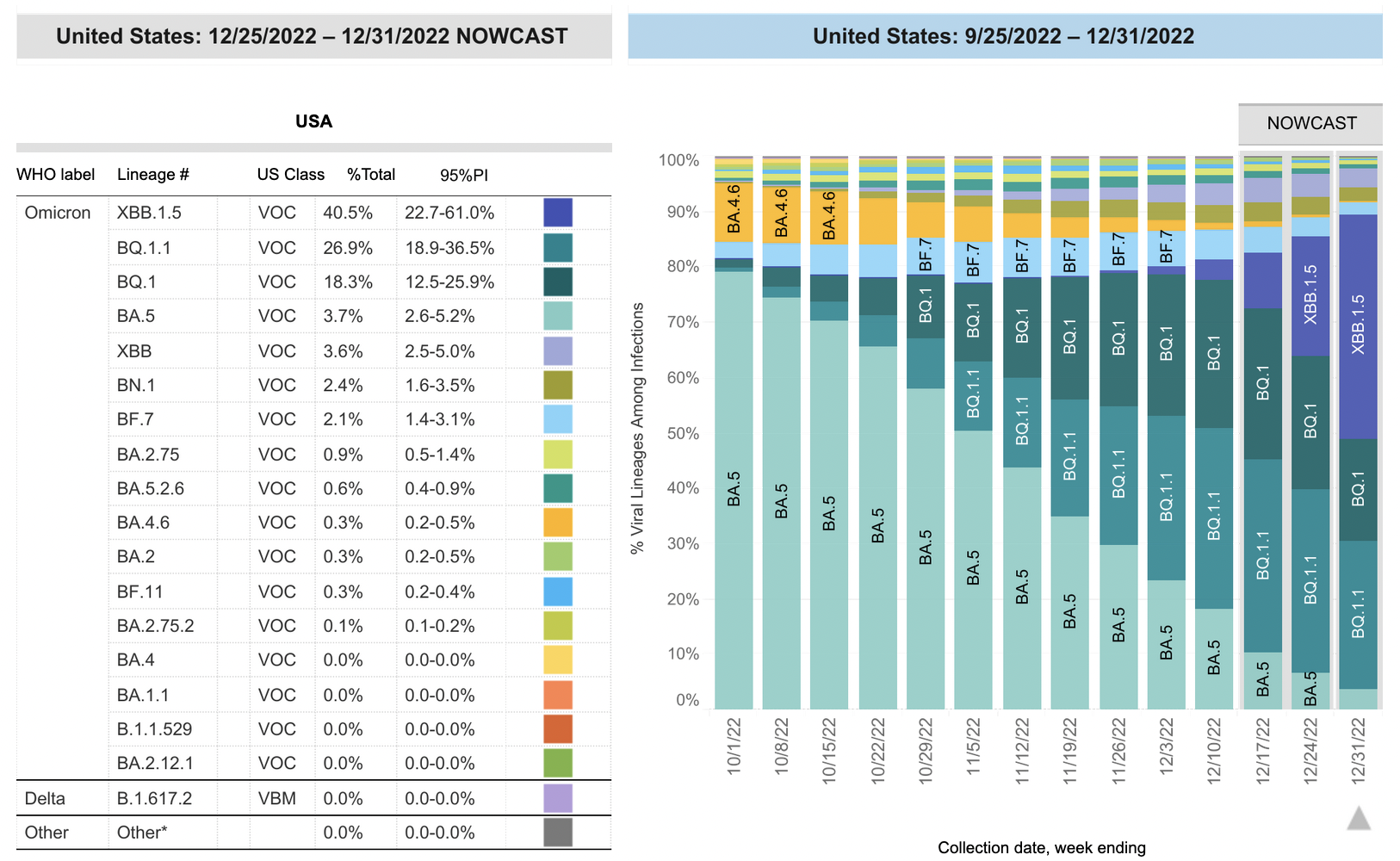The latest XBB.1.5 strain detected in Shanghai has risen strongly in the United States. Its significant growth advantage is due to new mutations that greatly enhance its binding to ACE2 (the new coronavirus receptor), and may also allow it to acquire more mutations.
Recently, the Global Initiative to Share All Influenza Data (GISAID) database added 369 new sequencing results of the new coronavirus in China, uploaded by Chen Saijuan of Ruijin Hospital Affiliated to Shanghai Jiaotong University School of Medicine (hereinafter referred to as “Shanghai Ruijin Hospital”) and Shanghai Public Health Clinic. Center (hereinafter referred to as “Shanghai Public Health Center”), a joint scientific research team led by Fan Xiaohong.
The Paper reporter learned that these samples came from patients with new crowns in Shanghai. They were randomly collected from November 23 to December 22 this year. Gene sequencing confirmed 30 known subtypes of Omicron, and no new coronaviruses have been found yet. mutant strain. Except for the “Southern Strain” BA.5.2 and “Northern Strain” BF.7 that met in Shanghai, the BQ.1 family and XBB family that are widely prevalent in Europe and the United States accounted for more than 1/3 – most of these cases were imported cases , is under closed-loop separate management, so it did not cause large-scale local spread of BQ.1 family and XBB family.
No new variants of the new coronavirus have emerged
According to the official report of Shanghai Ruijin Hospital, in order to assess the transmission mode of the Omicron strain in the country after adjusting the epidemic prevention measures, the above-mentioned research team analyzed the currently prevalent Omicron subtypes in the country. Research paper “Primary assessment of the diversity of Omicron sublineages and the epidemiologic features of autumn/winter 2022 COVID-19 wave in Chinese” mainland) was published in Frontiers of Medicine.
The researchers performed genome sequencing on 378 randomly selected samples from patients admitted to the Shanghai Public Health Center during the autumn and winter of 2022, and obtained 369 high-quality full-genome sequences of the new coronavirus. Molecular phylogenetic tree analysis found that these virus genomes contained 30 Aomecron subtype strains recorded in the GISAID database, of which 355 (95.95%) genome sequences were concentrated in 5 Aomecron sublineages, and the main strains Including BF.7 and BA.5.2 that have been reported to be popular in Beijing and Guangzhou, and BQ.1 and XBB that have recently appeared in Europe and the United States. Combined with the travel history and infection contact history of the infected person, it is proved that those with a history of contact with the epidemic in Beijing or Guangzhou mainly carried the BF.7 and BA.5.2 substrains respectively; the infected persons entering Shanghai from overseas mainly carried BQ.1 and XBB; In addition to BA.5.2, among the local infected persons, there are several Aomecron sub-strains with a relatively high proportion. No new coronavirus variants have been identified in these results.

 BQ.1 and XBB are the two most popular mutant strain families in Europe and America. BQ.1 is the sixth-generation subclade produced by the mutation of Omicron BA.5, and its sub-line BQ.1.1 has become the main epidemic strain in the world. XBB, which is a recombinant of two offspring mutant strains of Omicron BA.2, has a strong immune escape ability, and has become the main epidemic strain in Singapore within just two weeks after its emergence. The two are widely popular in Europe and the United States, and the upward trend is obvious. BA.5.2 and BF.7 (abbreviation for BA.5.2.1.7) also belong to the BA.5 subclade. According to a report by Singapore’s “Lianhe Zaobao” on December 30, a local data science research team in Singapore analyzed the virus genome sequences (from Beijing, Fujian, Guangzhou, Inner Mongolia and Sichuan) collected by the GISAID database during the new wave of epidemics in China, and cooperated with A comparison of 14.4 million sequences in the database found that they are closely related to known strains that have spread around the world from July to December this year, indicating that no new strains of the new coronavirus have appeared in China so far.
BQ.1 and XBB are the two most popular mutant strain families in Europe and America. BQ.1 is the sixth-generation subclade produced by the mutation of Omicron BA.5, and its sub-line BQ.1.1 has become the main epidemic strain in the world. XBB, which is a recombinant of two offspring mutant strains of Omicron BA.2, has a strong immune escape ability, and has become the main epidemic strain in Singapore within just two weeks after its emergence. The two are widely popular in Europe and the United States, and the upward trend is obvious. BA.5.2 and BF.7 (abbreviation for BA.5.2.1.7) also belong to the BA.5 subclade. According to a report by Singapore’s “Lianhe Zaobao” on December 30, a local data science research team in Singapore analyzed the virus genome sequences (from Beijing, Fujian, Guangzhou, Inner Mongolia and Sichuan) collected by the GISAID database during the new wave of epidemics in China, and cooperated with A comparison of 14.4 million sequences in the database found that they are closely related to known strains that have spread around the world from July to December this year, indicating that no new strains of the new coronavirus have appeared in China so far.
Reporters from The Paper learned that of the 369 cases sequenced by the Shanghai research team, there is currently no severe or symptomatic febrile patient, and no abnormalities in blood routine or inflammatory indicators have been detected. From the overall observation, the symptoms of BA.5.2 and BQ.1 are relatively mild, and the proportion of symptoms in BF.7 is slightly higher.
On December 26, Xu Wenbo, director of the Institute of Virology of the Chinese Center for Disease Control and Prevention, said in an interview with CCTV that from December 1 to 26, the whole genome sequencing of 1,142 cases had been completed nationwide, suggesting that BA5. The absolute dominance of the epidemic, the total of the two exceeds 80%. In addition, there are 7 subclades of the Aomecron variant strains that are prevalent in the country. No characteristic genome mutations have been found in these subtypes. At the same time, a total of 31 sub-branches of Omicron were found imported into China, including sub-branches such as BQ.1 and XBB that are spreading rapidly abroad.
“The pathogenicity of the new strain is not significantly different from other strains, and there are currently no reports of BQ.1 and XBB causing severe illness and increased death at home and abroad.” On December 20, the joint prevention and control mechanism of the State Council released a press release At the meeting, Xu Wenbo said that in the past three months, a total of more than 130 subclades of Omicron were imported into my country, of which BQ.1 and its subclades were detected in 9 provinces, and XBB subclades were detected in 3 provinces. He pointed out at the time that BQ.1 and XBB have not yet formed a dominant spread in China, but their spread advantage will gradually increase, together with the current domestic mainstream strains BA.5.2 and BF.7, plus more than 50 other imported sub-branches , may eventually form a co-circulation.

 XBB.1.5 menacing
XBB.1.5 menacing
It is worth noting that among the 25 XBB families monitored in Shanghai this time, there were 3 cases of XBB.1.5, all of which were also imported cases from abroad and did not cause local transmission. The researchers said that the virus strains in patients imported from abroad are relatively complex, and most of them were detected for the first time in my country. The current sequencing results show that there are many new virus strains imported from abroad, and routine detection of virus strains is still needed to provide a basis for subsequent scientific prevention and control.
In the United States, XBB.1.5 has quickly become the number one prevalent strain. The latest data from the US Centers for Disease Control and Prevention shows that in the past two weeks, XBB.1.5 has risen strongly in the United States and has replaced the dominant position of BQ.1.1 and BQ.1. This week (December 25-31) XBB.1.5 is expected to account for 40.5% of new crown cases in the United States, almost double the previous week (21.7%).
The latest research shows that the immune escape ability of XBB.1.5 is equivalent to that of XBB.1, but the key mutation F486P makes it have a higher binding affinity to the human ACE2 receptor – ACE2 can be regarded as the “gateway” for the new coronavirus to enter human cells , which means that XBB.1.5 is more likely to infect the human body. Tests have shown that even with at least two doses of mRNA vaccines, breakthrough infection BF.7 cannot induce high levels of neutralizing antibodies against XBB.1 and XBB.1.5, making it difficult to prevent reinfection.
Experts at home and abroad predict that XBB.1.5 will become the main virus strain in the world in a short period of time and needs to be closely watched. Another important reason is that the human ACE2 binding affinity of XBB.1.5 is almost equivalent to that of BA.2.75, which may allow XBB.1.5 to acquire more mutations like BA.2.75 in the future. Not going to evolve anytime soon.

 On December 24, Eric Topol, founder and director of the Scripps Research Translational Institute in the United States, put forward an “early warning” in his personal blog: XBB.1.5 is “in a blowout growth” . He pointed out with concern that the mutant strain was first detected in New York State, and the number of local hospitalizations (especially the elderly) has also risen sharply.
On December 24, Eric Topol, founder and director of the Scripps Research Translational Institute in the United States, put forward an “early warning” in his personal blog: XBB.1.5 is “in a blowout growth” . He pointed out with concern that the mutant strain was first detected in New York State, and the number of local hospitalizations (especially the elderly) has also risen sharply.
“Of course, other factors could have contributed to this outcome, such as reduced immunity, more frequent indoor gatherings, cold weather, lack of mitigation measures, etc. We don’t know to what extent XBB.1.5 is driving this process, but it depends It doesn’t look good. It at least contributed, and it would be too coincidental to see such a staggering co-increase in both numbers,” Topol wrote. development, only time will tell.”
The author of this article: Chen Zhuqin, the source of this article: The Paper, the original title: “Shanghai has detected 30 Omicron subtype strains in this round, and no increase in pathogenicity has been found”
Risk Warning and Disclaimer
Market risk, the investment need to be cautious. This article does not constitute personal investment advice, nor does it take into account the particular investment objectives, financial situation or needs of individual users. Users should consider whether any opinions, opinions or conclusions expressed herein are applicable to their particular situation. Invest accordingly at your own risk.
